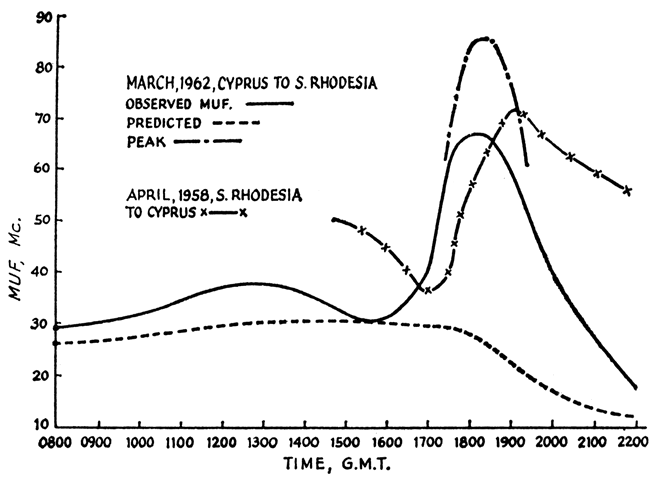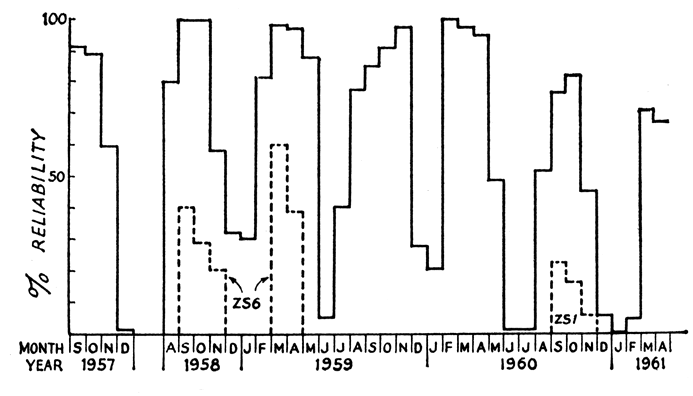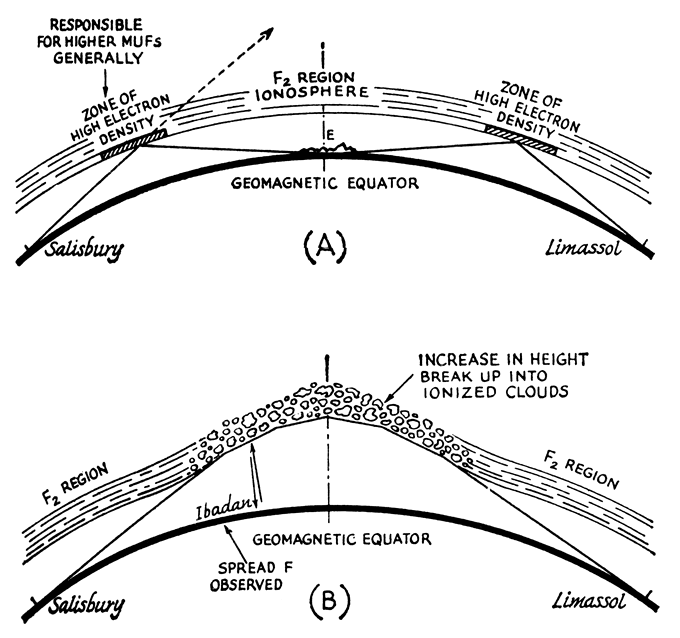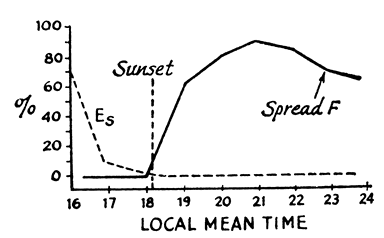|
TE Propagation - VHF
Discovery
[1963] A Quick Look Backward, Plus Latest Observations on the Cyprus to Southern Rhodesia Circuit One of the finest examples of amateur radio’s potential for worthwhile contributions to wave-propagation knowledge was the discovery and early use of transequatorial v.h.f. propagation. By 1947, when the first work of this kind was done, we were beginning to feel that radio-propagation phenomena were fairly well catalogued. Amateurs had sprung some valuable surprises in the past, but would it be very likely to happen again, now that the field had seen such extensive scientific scrutiny? By 1946, for example, there were propagation predictions available to anyone, purporting to show the approximate maximum usable frequency for long-distance communication between any two points on the earth’s surface, for any time of day, three months in advance. They indicated among other things that, as the peak of the sunspot cycle approached, the m.u.f. on certain north-south paths might be getting up close to 50 Mc, come October and November, 1947. So it did, though rather remarkably ahead of schedule, and at hours of the day that were at variance with all preconceived ideas. In late August, XE1KE, an avid ham with no professional propagation interests, found that he could work Argentine stations, notably LU6DO at first, quite regularly on 50 Mc. This was a good two months ahead of schedule, according to the predictions, and more important the contacts were made in late afternoon or early evening, when there should have been no possibility of. v.h.f. propagation over such distances. Coincidentally, W7ACS/KH6, near Pearl Harbor, Hawaii, worked VK5KL, Darwin, Australia, an unheard-of haul of more than 5000 miles - and this, too, at 1700 local time, instead of at the midday peak indicated in the predictions. These events were reported somewhat breathlessly by the writer in QST1, and word was spread through every available channel, including scientific agencies in Washington and elsewhere. The news created hardly a stir, outside of amateur radio circles, at first. People who knew their radio propagation tended to write off this 50 Mc. DX as some kind of freak occurrence that would not happen again. “Very interesting, but..." The polite brush-off. Fortunately, the hams who were making the contacts didn’t know that such propagation was impossible, so they kept on trying. XE1KE was joined by XE1GE, and soon they were working LUs and other South American amateurs by the score. This kept up all through the fall of 1947, always much later in the day than the hours indicated as high m.u.f. time in the predictions. Occasionally the band remained open far into the night. Signals were often fuzzy, but almost never weak, and they were in with almost clocklike regularity night after night. What was going on here? We asked the question repeatedly, in print and otherwise, as the evidence piled up month after month in the pages of QST, through the sunspot cycle peak in 1948, and for several years thereafter. Eventually these reports and the work of O. P. Ferrell2, long-time observer and reporter of amateur v.h.f. activity, had the desired effect. Scientific attention began to be focused on possible causes of these nocturnal band openings, but by now it was too late to do much about it. Forces were marshalled, however, for major assaults on the problem a few years hence3. Some theories were advanced, notably by Villard, which would explain the propagation on the basis of ionospheric conditions above the geomagnetic equator, much along the lines discussed later herein. With the steep-rising curve of another solar cycle upon us, interest in 50 Mc. DX grew by leaps and bounds in the middle and late ‘50s. This time there was more universal 50 Mc interest. Amateurs of many countries of the Far East, especially Japan, were now active on 50 Mc, and they soon showed that theirs was one of the most favored zones of the world for 6 meter openings. Many stations were on in Hawaii, Australia and New Zealand. South American activity levels were much improved. Perhaps most important of all, there was fairly extensive interest in parts of Africa, one area of which would eventually turn out to be an almost ideal spot from which to study the TE mode. This was Southern Rhodesia, where ZE2JY would take his place among 50 Mc immortals, through his daily beacon transmissions and receiving tests. If Southern Rhodesia seems an unlikely place for a dedicated v.h.f. enthusiast, then how about the Island of Cyprus, especially during the politically-troubled atmosphere of the late 1950s? But ZC4IP and ZC4WR took up the challenge, and the latter went through one of the most remarkable programs of amateur radio observation and investigation ever undertaken. The work of ZE2JV and ZC4WR is well documented in QST4, and the story need not be repeated here, but the latest evidence gathered, and reported below, is of more than ordinary interest. As it turned out, Cyprus and Salisbury, Southern Rhodesia, through their situation on a north-south line, equally spaced either side of a northerly bulge in the geomagnetic equator, probably are in as good positions as any two spots in the world for observation of vhf TE propagation. The work of these two amateurs, carried on daily for several years, entirely as a matter of personal. interest, and reported on in detail already, attracted the attention of scientific agencies and resulted in our two friends being recruited for scientific study of the mode in recent times. One result of this latter program, as yet incomplete, has been to show that TE propagation of vhf waves may be far less dependent on the solar cycle than has been previously assumed, at least as far as the most- favored areas of the world are concerned.
Evidence is shown in Fig. 1. The line broken by crosses shows the hourly average night time m.u.f., as observed by ZE2JV in April, 1958. This was a month typical of equinoctial periods during the highest portion of the solar cycle. It will be seen that the normal F2 m.u.f. to the north from ZE2JV would be above or near 50 Mc. during daylight hours, but would drop off around sunset. Then in the post-sunset period it would rise again, shooting up far above the daytime value, often remaining well above 50 Mc throughout the night. How would ZE2JV know this? TV and other commercial signals from much of Southern Europe would fill the tuning range of the general-coverage vhf, receiver, with which he tuned the frequencies up to 75 Mc nightly. Now turn to Fig. 2 for a moment. This is a histogram of the v.h.f. reception records kept by ZC4WR, with the help of ZC4IP, covering 1957 to 1961. The solid lines show the percentage of reliability of evening reception of the 50,04 Mc beacon signal of ZE2JV, supplemented to. some degree by other Southern Rhodesian and South African amateur signals. From this information we see that 50 Mc reception was possible very solidly in the equinoctial periods through early 1960. There is rather surprisingly persistent 50 Mc propagation through the fall of 1960 and the spring of 1961, long after the normal F2 m.u.f. had ceased to reach anywhere near the 50 Mc band.
Now, for
the blockbuster, turn back to Fig. 1. During March of 1962, ZC4WR, now
5B4WR, made daily m.u.f. observations, this time tuning up as far as an 87
Mc beacon signal now being provided by equipment operated by ZE2JV as part
of a research project sponsored by a scientific agency. The solid line
shows the average evening m.u.f. observed for the month up to nearly 70 Mc
briefly in the post-sunset period, with the 50 Mc band being open for
nearly 5 hours. On peak evenings, the m.u.f. reached 87 Mc! This is shown
by the broken line with dots. - E.P.T. How Does TE Work? BY B. A. WHITING, 5B4WR ANY explanation of the ionospheric mechanism which produces the rise in TE m.u.f. after sunset must, of course, take into account the known characteristics of the ionosphere in equatorial regions. Because of the effect of the earth’s magnetic field on the ionized layers of the earth’s atmosphere, in the vicinity of the geomagnetic equator, they display characteristics peculiar to this region. These characteristics have been observed on ionospheric sounders in areas close to the geomagnetic equator.
One such characteristic is an increase in the degree of ionization of the F2 region, with peaks in electron density contours occurring at around 15 degrees from the geomagnetic equator. The presence of these high-density zones, plus the higher level of ionization in general, accounts for the higher m.u.f.s observed ever north-south TB paths. This is illustrated in Fig. 3A for the normal two-hop signal path from Salisbury to Limassol via the F2 region. What then of the rise of TE m.u.f. after sunset, and the flutter fade observed? Although several explanations have been advanced to account for this effect, perhaps the simplest and most readily understood is illustrated in Fig. 3B. It also has the merit of taking into account the observed behavior of the F2 region of the ionosphere after sunset in the vicinity of the geomagnetic equator. This manifests itself as an increase in height of the F2 layer immediately after sunset, accompanied by the breakup of the layer into clouds of ionization, the effect lasting for several hours. Because the echoes returned from vertical incidence sounders during this period are diffused or spread out, due to scattering by the ionized clouds, the effect has been termed “Equatorial Spread F.” The phenomenon is illustrated in Fig. 3B, which also suggests diagrammatically how an increase in m.u.f. is possible. Due to tilts introduced in the F2 region, the radio wave encounters the layer at a lower angle of incidence than is normally possible, and by successive refraction is guided around inside the region to be returned to earth, in this case at Limassol, without an intermediate ground-reflection point5. Because of the presence of a higher degree of ionization and the lower angle of incidence, higher frequencies are refracted and the path m.u.f. rises. The elimination of an intermediate ground reflection point will reduce signal attenuation, and the scattering from the clouds of ionization produce the effect known as TE flutter fade. In fact, Equatorial Spread F has become closely associated with the flutter fade noticed on short wave signals in general, propagated across the geomagnetic equator during the period after sunset. The effect has become known to communication engineers as the “tropical sunset fading effect” - sufficient descriptive, I think you will agree. The presence of Equatorial Spread F undergoes generally the same seasonal changes in intensity and duration as have been observed on the post-sunset propagation of six- meter TE signals4. One other aspect of the ionosphere observed in the region of the geomagnetic equator is the presence of a permanent daytime belt of sporadic E which breaks up and disappears after sunset. On the two-hop signal path illustrated in Fig. 3A certain frequencies would be reflected from the top of this layer, on past records as high as 55 Mc on occasions. If signals are being reflected from the top of this layer, then its disappearance after sunset, by introducing additional attenuation, could account for the rather pronounced dip in signal levels observed on the six-meter band at sunset during the equinoxes. The presence of the sporadic-E layer is indicated in Fig. 3A. It has been observed to occur in a narrow belt centered on the geomagnetic equator and bounded by the dip latitudes of 10 degrees north and 10 degrees south. It should be noted that Figs. 3A and 3B are not to scale.
Fig. 4 illustrates the incidence of Equatorial Spread F after sunset, as observed at Ibadan, dip latitude 6 degrees south. It also shows the disappearance of sporadic E at sunset. It records for both phenomena the percentage of hourly observations when they were observed during September 1958. In the case of sporadic E, its presence was registered when its critical frequency was greater than or equal to 5 Mc. This graph should be compared with the diurnal 6-meter signal level variation for the same period over the Salisbury-Limassol path. Uses of TE Propagation information of the nature discussed provides the amateur a useful tool to extend the range of his contacts in both distance and frequency. From the information, presented we now know from what geographical locations we can take advantage of the peculiarities of TE propagation, what frequency bands can be used, and the time of day and season of the year when we can expect the best results. The most efficient mode of communication is c.w., in view of the fading pattern encountered, though voice is readable much of the time. To summarize, on north-south transequatorial circuits over paths symmetrically disposed with respect to the geomagnetic equator and of between 3000 and 4000 miles in length (this may be extended by other modes of propagation), reliable communication is possible using the amateur bands as high as 50 Mc during the three hours after local ground sunset time in the equinoctial periods. Signals propagated across TE circuits during these hours are subjected to a form of rapid fading. Less-reliable communication is possible on frequencies at least as high as 70 Mc. All this is possible using low-power amateur transmitting equipment and without special receivers or antennas. In view of its great potential for reliable communication, it must be assumed that the TE mode will take on ever greater importance, as this potential becomes more widely known and appreciated. References QST April 1963 Made by OK1TEH for OK2KKW.com pages - 2008 |



